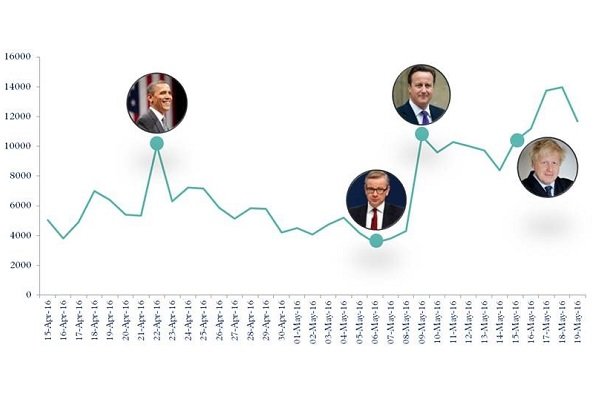With just under one month to go until the referendum on whether the UK will vote to Remain or Leave the EU, campaigners have been gearing up for the final push on and offline.
So we took the chance to look at the good, the bad and the ugly of what the campaigns have been doing online – and find out what issues and events have been driving the social conversation.
Examining all Twitter mentions of the hashtag #EURef from 15 April, the official start of the campaign, which both camps and the media have been generally coalescing around, we’ve mapped out some key moments and dug into how the campaigns represented themselves on social media.
Broadly we can see spikes in the conversations during the bigger set piece moments:
Barack Obama’s intervention on the Remain side led to a pretty significant bump in mentions. @StrongerIn capitalised on Obama’s popularity as a face for their online campaign by using him frequently in graphics.
By setting him next to infamously unpopular characters (at least in Britain) it highlights their prioritisation of high profile endorsements – coming from the worlds of politics, business and celebrity.
Barack Obama thinks the UK should stay in Europe. Donald Trump says we should leave. Enough said. Please RT. pic.twitter.com/furaIeLXIW
— Stronger In (@StrongerIn) April 22, 2016
@Vote_Leave on the other hand mastered the classic political tactic of using your opponents words to make your own point.
On the day of Obama’s speech to back Remain in the UK they put them in a Twitter video, using speech footage so there’s no possible way of claiming his words were taken out of context where Obama highlighted issues around immigration.
President Obama is clear. Uncontrolled migration is a major national security threat #VoteLeave #TakeControl pic.twitter.com/MvrVUvJ6J5
— Vote Leave (@vote_leave) 22 April 2016
A key moment for the @Vote_Leave campaign was Michael Gove’s public facing activity on their key theme of #TakeControl.
Live broadcast on social means a speech is no longer an exercise for a group of 50 convinced activists and a press pack, it’s now a tool that can be used in real time to reach online communities and show that your campaign is active and out there.
WATCH LIVE Michael Gove’s speech on why we should #TakeControl on 23 June. https://t.co/LadDyOyqcW pic.twitter.com/hp9lPbQ4D7
— Vote Leave (@vote_leave) 19 April 2016
Stronger In responded quickly with their own tweet on the speech… showing the frank tone this EU referendum has taken. This type of content does prove popular though, when pushed out in real time.
Earning 243 retweets, despite relying on Twitter users understanding the context of Gove’s position in the debate and what his speech would have been on. It has also allowed Stronger In to pivot a Vote Leave campaign moment back to their key message – whatever Leave say it’s too risky.
Missed Michael Gove’s speech?
Here’s a summary of his key points: pic.twitter.com/acvcqzOQEh
— Stronger In (@StrongerIn) April 19, 2016
A big day for the campaign was on 9th May, which saw the Prime Minister and Boris Johnson giving speeches in quick succession. In the head-to-head match up, the Prime Minister clearly came out on top on Twitter with his comments driving the conversation.
Most of the Twitter coverage of the speech stemmed from activity on the government’s @Number10gov feed, rather than @StrongerIn’s, where there are 4.4 million followers.
Turns out that there is multiple uses to government’s resources and public reach, it’s not only about sending out door-drops for ‘free’!
Unsurprisingly Boris Johnson features heavily throughout the campaign – with one of the biggest days of Twitter mentions being when he announced officially for Leave.
On the 15th May Boris Johnson compared the EU state to Napoleon and Hitler’s efforts to build a European super-state.
Despite a huge surge in mentions on Twitter of both ‘Boris’ and ‘Hitler’ that day as people express surprise (and often distaste) of his analogy, especially following Ken Livingstone’s remarks in recent weeks, it hasn’t caused a surge in activity on the #EURef hashtag.
Was this a slip of the tongue damaging to brand-Boris, more than influential on the EU debate? (There were 27k mentions of Boris Johnson on Twitter that day, compared to 2.5k the day before). Stronger In used it as an opportunity to ridicule opposition spokespeople. Unsurprisingly, @Vote_Leave have avoided using the word ‘Hitler’ on their feed…
Hague: “Boris, citing Hitler at the weekend, was positively Trumpian” https://t.co/5vvra6S78Y pic.twitter.com/HQzdEVzZPf
— Stronger In (@StrongerIn) May 17, 2016
To dig deeper we visualised the words in the tweets around the #EUref. The key players in the debate were all there with the policy area that appears the most alongside #EUref being ‘immigration’, whereas ‘economy’ is noticeably absent (not a good sign for In campaign!)
Even the Home Secretary knows we cannot control our borders whilst we’re in the EU. Let’s #TakeControl on 23 June pic.twitter.com/yU2N4zlekI
— Vote Leave (@vote_leave) April 24, 2016
@Vote_Leave have met and stoked that interest with a daily drumbeat of immigration themed graphics – which all perform pretty well for the campaign. With this, somewhat unexciting graphic, receiving over 500 retweets.
There will be a mixture of amusing gaffs and more serious posts from both sides in the month ahead, as they try and cut through the social bubble to voters with their messages.
But if either campaign can get the mix of priorities correct: getting their message out, raising money through small donations and trying mobilise offline activity, then in a tight campaign, their digital channels may help give them the winning edge.


